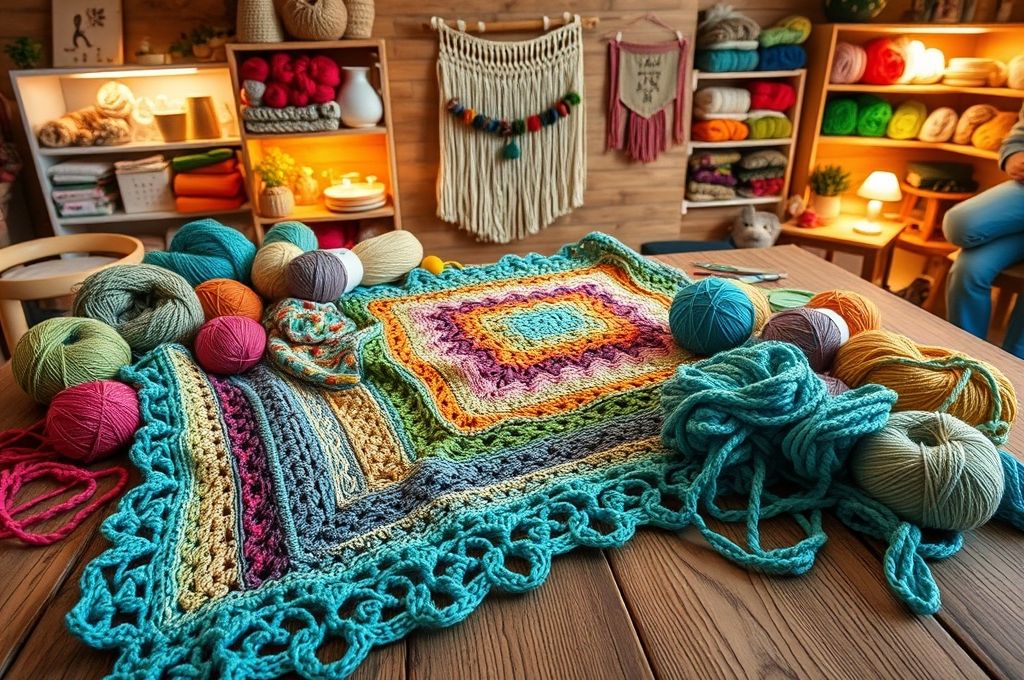Have you ever picked up your crochet hook, stared at a half-finished project, and thought, “I wish I could see this through someone else’s eyes”? Maybe you’ve had a brilliant idea but didn’t know how to bring it to life—or perhaps you’ve felt stuck in a creative rut, repeating the same patterns over and over. If so, you’re not alone. Many crocheters and designers experience moments of isolation or creative block. But here’s the good news: you don’t have to craft alone.
Collaborating with other crocheters and designers can breathe new life into your passion. Whether you’re a hobbyist who loves making cozy blankets or a professional designer launching your own pattern line, working with others opens doors to fresh ideas, expanded skills, and deeper inspiration. In fact, some of the most beloved crochet projects and collections were born not from solitary effort, but from creative partnerships.
In this article, we’ll explore why collaboration is such a powerful tool in the crochet world. We’ll dive into the many benefits—from learning new techniques to building supportive communities—and share practical ways you can start collaborating today. You’ll discover how joint projects can lead to innovation, how online platforms are making it easier than ever to connect, and how even small collaborations can have a big impact on your growth as a crafter.
Whether you’re looking to expand your design portfolio, gain confidence in your skills, or simply make new friends who get your love for yarn, this guide will show you how to harness the power of teamwork. Let’s unravel the magic that happens when crocheters come together.
Why Collaboration Matters in the Crochet Community
Crochet has always been more than just a craft—it’s a form of self-expression, storytelling, and connection. And while it’s often seen as a solo activity, its roots are deeply communal. Think back to generations ago, when women gathered on porches or in living rooms, sharing stitches, patterns, and stories. That tradition of community hasn’t disappeared; it’s evolved.
Today, collaboration in the crochet world isn’t just nostalgic—it’s essential. When you work with other crocheters and designers, you tap into a shared pool of knowledge, creativity, and encouragement. You gain access to new techniques, different cultural perspectives, and innovative design ideas you might never have considered on your own.
For example, imagine you’ve mastered the basics of amigurumi but struggle with shaping more complex animal features. By collaborating with a designer who specializes in 3D crochet, you could learn advanced shaping techniques while contributing your own flair for color and texture. The result? A unique, co-designed plush toy that neither of you could have created alone.
Beyond skill-sharing, collaboration fosters emotional support. Crafting can sometimes feel lonely, especially if you’re working from home or don’t have local crafting groups. Partnering with others creates accountability, motivation, and friendship. A simple message like “Can’t wait to see what you make with this yarn!” can be the boost you need on a tough day.
In short, collaboration turns crochet from a personal pastime into a shared journey—one where everyone grows together.
Building Creative Synergy: How Two Minds Are Better Than One

Have you ever noticed how a simple idea can explode into something extraordinary when discussed with someone else? That’s creative synergy—the magic that happens when two or more people combine their strengths, perspectives, and imaginations.
In crochet, this synergy is especially powerful. One person might excel at intricate lace patterns, while another has a gift for bold color combinations. When they collaborate, the result isn’t just a mix of styles—it’s something entirely new. Think of it like a musical duet: each voice brings its own tone, rhythm, and emotion, but together, they create harmony.
Take the example of the “Rainbow Ripple Blanket” project started by two designers from different countries. One lived in Norway and loved minimalist, structured designs. The other was from Brazil and adored vibrant, flowing patterns. They decided to combine their styles: the Norwegian designer created the base ripple stitch pattern, while the Brazilian designer chose the color palette and added floral motifs at the edges. The final piece was featured in a major crochet magazine and inspired hundreds of recreations worldwide.
This kind of collaboration doesn’t require fame or a big platform. Even small partnerships—like designing a matching set of hats and scarves with a friend—can lead to unexpected breakthroughs. You might discover a new favorite stitch, experiment with a yarn type you’ve never tried, or finally tackle that sweater pattern you’ve been intimidated by.
The key is openness. Be willing to listen, share, and let go of total control. Great collaborations thrive on trust and mutual respect. When both parties feel valued, the creative energy flows freely—and the results speak for themselves.
Finding the Right Partners: Where and How to Connect
Now that you’re excited about collaboration, you might be wondering: Where do I even start? Who should I work with?
The good news is that the crochet community is vast, welcoming, and more connected than ever—thanks largely to the internet. Whether you’re looking for a local buddy to crochet with or a global partner for a design challenge, there are countless ways to find your creative match.
Start with online communities. Platforms like Ravelry, Instagram, and Facebook groups are goldmines for connecting with fellow crocheters. Search for hashtags like #crochetcollab, #designerteamup, or #yarnfriends. Join groups focused on specific interests—amigurumi, wearable art, sustainable yarns—and start engaging. Comment on posts, share your work, and don’t be afraid to say, “I’d love to collaborate on something like this!”
Attend virtual or in-person events. Craft fairs, yarn festivals, and online crochet-alongs (CALs) are perfect opportunities to meet like-minded makers. Many of these events include networking sessions or partner-matching activities. Even if you’re shy, a simple “I love your color choices—have you ever thought about doing a joint blanket project?” can spark a meaningful connection.
Look within your existing circle. Sometimes, the best collaborator is already in your life—a friend, family member, or coworker who also crochets. Reach out and suggest a small project: a coordinated gift for a loved one, a charity blanket drive, or even a friendly design challenge.
When choosing a partner, consider compatibility in style, work pace, and communication. A successful collaboration isn’t just about skill—it’s about trust, reliability, and shared vision.
Types of Crochet Collaborations You Can Try

Not all collaborations look the same—and that’s the beauty of it. Depending on your goals, you can engage in a variety of partnership formats, each offering unique rewards.
1. Design Duos
Two designers team up to create a single pattern or collection. This is common in sweater or accessory sets—like a hat, scarf, and mittens bundle. Each designer handles a piece, ensuring cohesion in color and stitch style.
2. Crochet-Alongs (CALs)
A group works on the same project simultaneously, often guided by a host or designer. CALs build excitement and accountability. You can host your own or join an existing one. Platforms like Ravelry and YouTube make it easy to share progress and tips.
3. Yarn Collaboration
Work with a yarn company or indie dyer to create an exclusive colorway or kit. This is especially popular among designers who want to launch their own branded products. For example, a designer might partner with a small-batch yarn maker to release a “limited edition” kit for a shawl pattern.
4. Charity Projects
Join or organize a group effort to make blankets, hats, or toys for those in need. Hospitals, shelters, and nonprofits often welcome handmade donations. Collaborative charity work is deeply fulfilling and strengthens community bonds.
5. Skill Swap Partnerships
Pair up with someone who has a skill you want to learn—maybe they’re great at charting patterns, or you’d love to master Tunisian crochet. In exchange, you teach them something you’re good at, like photo editing or marketing your designs.
6. Social Media Challenges
Launch a themed challenge with a friend: “7 Days of Granny Squares” or “One Skein Wonders.” Encourage others to join, share photos, and tag each other. These challenges go viral easily and can grow your audience.
Each type of collaboration offers a different experience. Start small, see what resonates, and build from there.
Overcoming Common Collaboration Challenges
Even the best partnerships can face bumps in the road. Miscommunication, differing expectations, or creative disagreements are all possible—but they don’t have to derail your project.
One of the most common issues? Unequal effort. One person does most of the work, while the other fades away. To prevent this, set clear roles from the start. Use a simple agreement (even just a text message) outlining who’s responsible for what—writing the pattern, sourcing materials, promoting the project, etc.
Another challenge is creative differences. What if you love bold colors, but your partner prefers neutrals? Instead of seeing this as a conflict, treat it as an opportunity. Compromise by using a neutral base with pops of color in the details. Or design two versions of the same pattern—one minimalist, one vibrant—and offer both as options.
Communication breakdowns are also common, especially in long-distance collaborations. To stay aligned, schedule regular check-ins—weekly video calls or even quick voice notes. Use shared tools like Google Docs for pattern drafts or Trello boards to track progress.
And don’t forget about credit and ownership. Always discuss how you’ll share recognition. Will both names appear on the pattern? How will sales revenue be split? Transparency builds trust and prevents resentment later.
Remember: every challenge is a chance to grow. A little patience, flexibility, and honesty can turn obstacles into stepping stones.
Real-Life Success Stories: Inspiration from the Crochet World
Sometimes, the best motivation comes from real examples. Let’s look at a few inspiring collaborations that started small but made a big impact.
The “Sisterhood Blanket” Project
Two crocheters—one in Canada, one in Australia—connected on Instagram after bonding over their love for granny squares. They decided to create a “Sisterhood Blanket,” where each contributed 12 squares, then mailed them to each other to assemble into one large throw. They documented the process online, and their story went viral. Hundreds of women joined in, forming a global “Sisterhood” crochet circle that continues today.
The “Colorwave Shawl” Collection
Three indie designers from the U.S., Germany, and Japan launched a joint shawl collection based on the theme of oceans. Each designed a shawl inspired by their local sea—Pacific, Baltic, and Sea of Japan. They used a shared color palette and released the patterns simultaneously. The collection was a hit, praised for its cultural diversity and stunning visuals.
The “Yarn & Soul” Podcast
Two crochet therapists (yes, that’s a real thing!) started a podcast to explore how crafting supports mental health. They alternate hosting duties, interview guests, and share personal stories. Their collaboration has helped thousands feel less alone in their struggles—and even inspired a line of mindfulness crochet kits.
These stories show that collaboration isn’t just about making pretty things—it’s about making a difference. Whether it’s building community, celebrating diversity, or supporting well-being, creative partnerships can ripple outward in powerful ways.
How Collaboration Boosts Your Skills and Confidence
You might think collaboration is mainly about the end product—but one of its greatest benefits is personal growth.
When you work with others, you’re constantly learning. You observe how they approach problems, structure patterns, or choose yarns. You pick up new stitches, techniques, and design principles just by being in their creative orbit.
But it’s not just technical skills that improve. Collaboration also builds confidence. Sharing your work with a partner means opening yourself up to feedback—and that can be scary. Yet, constructive criticism from someone you trust is one of the fastest ways to grow. A simple comment like “Have you tried increasing here instead?” can unlock a new level of precision in your work.
Additionally, collaboration reduces the fear of failure. When you’re part of a team, mistakes feel less like personal shortcomings and more like shared learning experiences. You’re not alone in the process, and that safety net encourages you to take creative risks—like trying a new stitch, launching your first paid pattern, or teaching a workshop.
Over time, these experiences build not just skill, but creative courage. You start to see yourself not just as a crocheter, but as a designer, a collaborator, a contributor to a larger community.
And that shift in mindset? It’s priceless.
Digital Tools That Make Collaboration Easier Than Ever
Gone are the days when collaboration meant meeting in person or mailing pattern drafts through snail mail. Today, a suite of digital tools makes it easier than ever to work with crocheters and designers across the globe.
Ravelry remains a cornerstone of the online crochet world. Its project pages, forums, and pattern hosting features are ideal for group projects. You can create a dedicated group for your collaboration, share updates, and even sell joint patterns.
Google Workspace (Docs, Sheets, Drive) allows real-time collaboration on pattern writing, budgeting, and planning. Share a document, and both of you can edit simultaneously—perfect for refining instructions or brainstorming ideas.
Trello or Notion helps organize complex projects. Create boards for “To-Do,” “In Progress,” and “Completed,” assign tasks, and set deadlines. Visual project management keeps everyone on track.
Zoom or Google Meet enables face-to-face check-ins, even across time zones. A 15-minute weekly call can keep momentum going and strengthen your connection.
Canva or Adobe Express lets you create beautiful promotional graphics for your joint project—social media posts, pattern covers, or email newsletters.
And don’t underestimate the power of WhatsApp or Discord for casual, ongoing communication. Quick voice messages, photo shares, and emoji reactions keep the energy light and fun.
With these tools, distance isn’t a barrier—it’s just another thread in the tapestry of your collaboration.
From Hobby to Business: How Collaboration Can Grow Your Brand
If you’re a designer looking to turn your passion into a sustainable business, collaboration is one of the smartest strategies you can use.
Why? Because it instantly expands your reach. When you partner with another designer, you’re not just combining skills—you’re merging audiences. Their followers see your work, and yours see theirs. It’s like a built-in marketing boost.
For example, imagine you have 2,000 Instagram followers, and your collaborator has 3,000. When you launch a joint pattern, you’re potentially exposing your work to 5,000 people—many of whom may become loyal fans.
Collaborations also enhance credibility. Being chosen as a partner signals that you’re respected in the community. Customers are more likely to trust and purchase from designers who collaborate with others, seeing it as a mark of professionalism and creativity.
You can monetize collaborations in several ways:
- Sell co-designed patterns on Etsy or Ravelry
- Offer limited-edition kits with custom yarn and printed patterns
- Host paid workshops or webinars together
- Launch a Patreon or membership site with exclusive collaborative content
Even if you’re not ready to sell, collaborating builds your portfolio and strengthens your reputation. Over time, these partnerships can open doors to bigger opportunities—like being featured in magazines, working with yarn brands, or speaking at craft events.
In short, collaboration isn’t just fun—it’s a smart career move.
The Ripple Effect: How Your Collaboration Can Inspire Others
Here’s something beautiful to consider: your collaboration doesn’t just benefit you and your partner. It creates a ripple effect that touches others in ways you might never expect.
When people see your joint project—whether it’s a stunning shawl, a heartwarming charity drive, or a fun social media challenge—they’re inspired to create too. A beginner might think, “If they can do it, so can I.” A lonely crafter might reach out to start their own partnership. A parent might decide to teach their child to crochet, inspired by your shared journey.
Every public collaboration becomes a quiet act of encouragement. It shows that creativity thrives in community, that differences can lead to beauty, and that no one has to craft alone.
And the more visible you make your process—the behind-the-scenes photos, the challenges you overcame, the laughter you shared—the more relatable and inspiring it becomes.
So don’t underestimate the power of your partnership. It’s not just about the stitches or the final product. It’s about the message it sends: We made this together. And you can, too.
Conclusion: Start Small, Dream Big, and Crochet Together
Collaborating with other crocheters and designers isn’t just a way to make better projects—it’s a way to enrich your entire crafting journey. From learning new skills and gaining confidence to building meaningful relationships and growing your creative business, the benefits are endless.
We’ve explored how to find the right partners, the types of collaborations you can try, and the tools that make teamwork seamless. We’ve seen real stories of success and learned how to navigate challenges with grace. Most importantly, we’ve seen how collaboration creates ripples—inspiring others, strengthening communities, and keeping the spirit of handmade alive.
Now, it’s your turn.
Start small. Send a message to someone whose work you admire. Propose a tiny project—two matching coasters, a mini crochet-along, a shared Instagram post. See how it feels. Let the connection grow naturally.
Because at the heart of every great collaboration is a simple act: reaching out.
So pick up your hook, open your heart, and weave something beautiful—not just with yarn, but with people.
What’s one collaboration idea you’d love to try? Share it in the comments below—or better yet, tag a fellow crocheter and make it happen!

Daniele Ferreira is passionate about the world of crochet, dedicating her time to exploring techniques, creating unique pieces, and sharing her knowledge with beginners and aficionados alike. With attention to detail and creativity, she transforms yarn into true works of art, inspiring others to discover the beauty and joy of this manual art.







